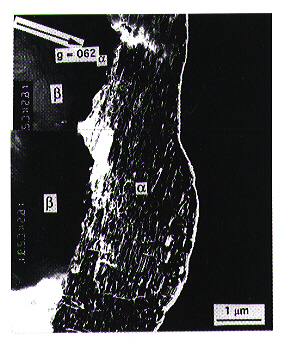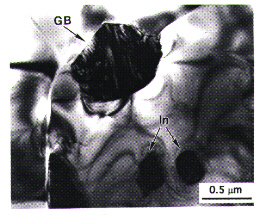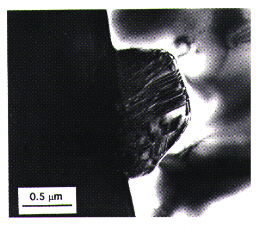

Phase transformations of olivine (alpha-phase), and its high-pressure polymorphs wadsleyite (beta-phase) and ringwoodite (gamma-phase) are believed to influence strongly the dynamics of lithospheric subduction, mantle rheology, the state of stress in slabs, and may be responsible for the occurrence of deep-focus earthquakes. Because subducting slabs are likely to be in a state of non-hydrostatic stress, it is important to investigate the effect of stress on transformation and deformation mechanisms of these phases.
We have studied the effect of non-hydrostatic stress on the mechanisms of the alpha to beta and beta to gamma transformations and the deformation mechanisms of olivine and wadsleyite at relatively low temperature. High-pressure experiments were performed on a San Carlos olivine starting material in a multi-anvil apparatus using an assembly designed to impose a non-hydrostatic stress on the sample. Experiments were performed at 900°C in the beta-stability field (15 GPa) for 0.5 h and in the beta+gamma stability field (16 GPa) for 11 h, to produce samples for microstructural characterisation with optical and transmission electron microscopy.
Although reacted under non-hydrostatic stress, there is no evidence
for transformational faulting in our samples. In the 15 Gpa sample, partially-consumed
olivine grains were replaced by wadsleyite grains elongated parallel to
the principal compressive stress, thus defining a grain-shape anisotropy.
The remnant olivine grains contain high densities of mostly [001] dislocations
(Fig. 3.1-2) and deformation occurs by dislocation glide involving the
slip systems (010)[001] and (100)[001]. The sample deformed at 16 GPa was
almost totally transformed to wadsleyite. There is a strong variation in
the wadsleyite grain size from 1-2 µm near
the ends of the sample column to ~30 µm at
the centre where the temperature
 |
Fig. 3.1-2: Weak-beam dark-field TEM image of [001] dislocations in olivine which have straight segments parallel to [100] and [011]. |
was the highest. Dislocations in wadsleyite grains (grain size >2 µm)
are in a climb configuration suggesting that self-diffusion of Si and/or
O is much faster in wadsleyite than in olivine at 900°C. Wadsleyite
transforms to ringwoodite by two competing mechanisms: (1) coherent intracrystalline
transformation involving nucleation on a dislocations, probably
where they intersect (010)beta stacking faults
(see Annual Report 1996) and (2) partially-coherent transformation involving
nucleation at wadsleyite grain boundaries. Grain boundary nucleation occurs
at a slower rate than intracrystalline nucleation under our experimental
conditions (Fig. 3.1-3). In addition, there is evidence that incoherent
interphase boundaries migrate faster than coherent boundaries (Fig. 3.1-4).
Dislocations and intracrystalline nucleated ringwoodite are not present
in the smallest wadsleyite grains (1-2 µm),
which suggests that the rate of intracrystalline beta->gamma transformation
is grain size-dependent. Because the rate of intracrystalline nucleation
increases with the density of dislocations, non-hydrostatic stress in subducting
lithosphere is likely to enhance the kinetics of the wadsleyite->ringwoodite transformation.
 |
 |
Fig. 3.1-3: Intracrystalline coherent ringwoodite grains in wadsleyite (labelled In) and a ringwoodite grain which has nucleated at a grain boundary (labelled GB). The ringwoodite grain at the grain boundary is larger than the intracrystalline grains, suggesting that the former grew relatively rapidly. |
Fig. 3.1-4: Ringwoodite grain growing at a wadsleyite grain boundary, which is coherent with the strongly diffracting (black) wadsleyite grain, but incoherent with the other (light grey) wadsleyite grain. |

Tel: +49-(0) 921 55 3700 / 3766, Fax: +49-(0) 921 55 3769, E-mail: bayerisches.geoinstitut(at)uni-bayreuth.de
 Previous page
Previous page